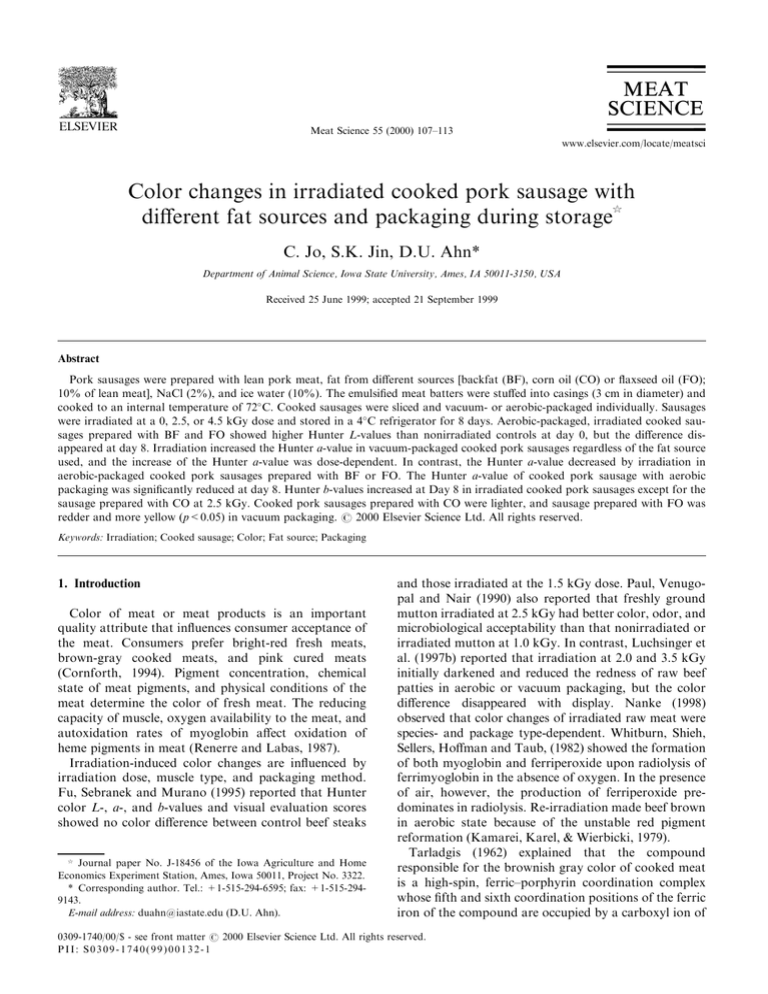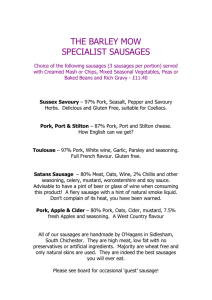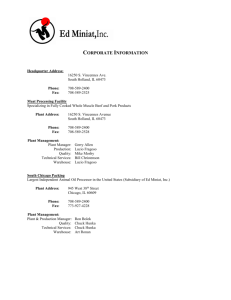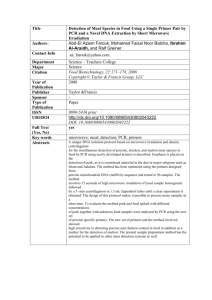
Meat Science 55 (2000) 107±113
www.elsevier.com/locate/meatsci
Color changes in irradiated cooked pork sausage with
dierent fat sources and packaging during storage
$
C. Jo, S.K. Jin, D.U. Ahn*
Department of Animal Science, Iowa State University, Ames, IA 50011-3150, USA
Received 25 June 1999; accepted 21 September 1999
Abstract
Pork sausages were prepared with lean pork meat, fat from dierent sources [backfat (BF), corn oil (CO) or ¯axseed oil (FO);
10% of lean meat], NaCl (2%), and ice water (10%). The emulsi®ed meat batters were stued into casings (3 cm in diameter) and
cooked to an internal temperature of 72 C. Cooked sausages were sliced and vacuum- or aerobic-packaged individually. Sausages
were irradiated at a 0, 2.5, or 4.5 kGy dose and stored in a 4 C refrigerator for 8 days. Aerobic-packaged, irradiated cooked sausages prepared with BF and FO showed higher Hunter L-values than nonirradiated controls at day 0, but the dierence disappeared at day 8. Irradiation increased the Hunter a-value in vacuum-packaged cooked pork sausages regardless of the fat source
used, and the increase of the Hunter a-value was dose-dependent. In contrast, the Hunter a-value decreased by irradiation in
aerobic-packaged cooked pork sausages prepared with BF or FO. The Hunter a-value of cooked pork sausage with aerobic
packaging was signi®cantly reduced at day 8. Hunter b-values increased at Day 8 in irradiated cooked pork sausages except for the
sausage prepared with CO at 2.5 kGy. Cooked pork sausages prepared with CO were lighter, and sausage prepared with FO was
redder and more yellow (p<0.05) in vacuum packaging. # 2000 Elsevier Science Ltd. All rights reserved.
Keywords: Irradiation; Cooked sausage; Color; Fat source; Packaging
1. Introduction
Color of meat or meat products is an important
quality attribute that in¯uences consumer acceptance of
the meat. Consumers prefer bright-red fresh meats,
brown-gray cooked meats, and pink cured meats
(Cornforth, 1994). Pigment concentration, chemical
state of meat pigments, and physical conditions of the
meat determine the color of fresh meat. The reducing
capacity of muscle, oxygen availability to the meat, and
autoxidation rates of myoglobin aect oxidation of
heme pigments in meat (Renerre and Labas, 1987).
Irradiation-induced color changes are in¯uenced by
irradiation dose, muscle type, and packaging method.
Fu, Sebranek and Murano (1995) reported that Hunter
color L-, a-, and b-values and visual evaluation scores
showed no color dierence between control beef steaks
$
Journal paper No. J-18456 of the Iowa Agriculture and Home
Economics Experiment Station, Ames, Iowa 50011, Project No. 3322.
* Corresponding author. Tel.: +1-515-294-6595; fax: +1-515-2949143.
E-mail address: duahn@iastate.edu (D.U. Ahn).
and those irradiated at the 1.5 kGy dose. Paul, Venugopal and Nair (1990) also reported that freshly ground
mutton irradiated at 2.5 kGy had better color, odor, and
microbiological acceptability than that nonirradiated or
irradiated mutton at 1.0 kGy. In contrast, Luchsinger et
al. (1997b) reported that irradiation at 2.0 and 3.5 kGy
initially darkened and reduced the redness of raw beef
patties in aerobic or vacuum packaging, but the color
dierence disappeared with display. Nanke (1998)
observed that color changes of irradiated raw meat were
species- and package type-dependent. Whitburn, Shieh,
Sellers, Homan and Taub, (1982) showed the formation
of both myoglobin and ferriperoxide upon radiolysis of
ferrimyoglobin in the absence of oxygen. In the presence
of air, however, the production of ferriperoxide predominates in radiolysis. Re-irradiation made beef brown
in aerobic state because of the unstable red pigment
reformation (Kamarei, Karel, & Wierbicki, 1979).
Tarladgis (1962) explained that the compound
responsible for the brownish gray color of cooked meat
is a high-spin, ferric±porphyrin coordination complex
whose ®fth and sixth coordination positions of the ferric
iron of the compound are occupied by a carboxyl ion of
0309-1740/00/$ - see front matter # 2000 Elsevier Science Ltd. All rights reserved.
PII: S0309-1740(99)00132-1
108
C. Jo et al. / Meat Science 55 (2000) 107±113
the denatured globin molecule and water, respectively.
Tarladgis and Ehtashan-Ud-Din (1965) interpreted that
the color changes in cooked meat after ionizing radiation were caused by the conversion of a high-spin ferriporphyrin to a low-spin ferroporphyrin compound. At
least one ligand of the iron in the metmyochromogen
was dissociated from the complex and was replaced by a
less electronegative group present in the medium. The
new ligand is then responsible for the gradual change in
the spin state of iron. At the same time, some of the iron
was being reduced. Ahn and Maurer (1990a) have
shown that histidine, proteins, pyridine, and nicotinamide are very eective heme-complex-forming ligands
with myoglobin, hemoglobin, and cytochrome c. They
also reported that the concentration of the ligand and
the pH of the system are very critical in the heme-complex-forming reactions of the pigments (Ahn & Maurer,
1990b). Shaw, Claus and Stewart (1992) reported that
exposure of raw pork loin chops to ammonia resulted in
a distinct pink color after cooking to 80 C, but samples
cooked and then exposed to ammonia failed to develop
pink color. The authors interpreted that the pH shift
caused by ammonia is responsible for pink color development in cooked meat. Shahidi, Pegg and Sham Suzzaman, (1991) studied the eect of irradiation on the
color and oxidative stability of meat treated with nitrite
or a nitrite-free curing system and found that irradiation
had no detrimental eect on the color of either cured or
nitrite-free meat. The degree of saturation of a fatty acid
aects oxidation rate signi®cantly. The relative reaction
rate of linolenic acid (C18:3) with oxygen is much faster
than that of linoleic acid (C18:2) and oleic acid (C18:1)
(Frankel, 1991). In the muscle system, the oxidation of
fatty acids catalyzes the formation of metmyoglobin, or
the reaction couples, and vice versa. So far, however,
information on irradiation-induced color changes in
cooked meat products is limited. The objective of this
study was to determine the eect of irradiation on color
changes of cooked pork sausages prepared with dierent
fat sources and packaging during storage.
2. Materials and methods
2.1. Sample preparation
Lean pork was purchased from a local meat packer
and ground through a 9-mm plate twice. Pork sausages
were prepared with the lean meat, dierent fat sources
(backfat, corn oil or ¯axseed oil; 10% of lean meat),
NaCl (2%), and ice water (10%). The emulsi®ed meat
batters were stued into collagen casings (3-cm diameter) and cooked in a smoke house (programed at
54.4 C for 30 min, increased to 65.6 C and held for 30
min, and then increased to 82.2 C and held until the
internal temperature reached to 72 C). After cooling in
ice water for 20 min, sausages were peeled and sliced by
electric slicer into 2 cm-thick pieces (approximately 30
g). Sliced sausage pieces were placed in a bag to have
both cut-ends face the ¯at sides of a bag. Sliced sausage
pieces were vacuum-packaged individually into oxygen
impermeable nylon/polyethylene bags (9.3 ml O2/m2/24
h at 0 C; Koch, Kansas City, MO) to minimize oxidative changes during the delay between sample preparation and irradiation. The packaging bags used for this
study were not approved for electron beam irradiation
process.
2.2. Irradiation
Sausages were irradiated at a 0, 2.5, or 4.5 kGy dose
using an Electron Beam irradiator (Circe IIIR Thomson
CSF Linac, St. Aubin, France) with a 10 MeV energy
level, a 10 kw power level, and an average 98 kGy/min
dose rate after storage overnight in a 4 C cooler. The
irradiation process was conducted at room temperature
with single layer display and single-sided dosage. The
max/min ratio was approximately 1.180.15 for 2.5
kGy and 1.260.17 for 4.5 kGy. The samples were
returned to the cooler immediately after irradiation.
Half of the samples were stored in a vacuum, and the
other half were stored in aerobic packaging. Samples to
be irradiated and stored in aerobic packaging were cut
open and ¯ushed with air before irradiation. To con®rm
the target dose, two alanine dosimeters per cart were
attached to the top and bottom surfaces of the sample.
The alanine dosimeter was read using a 104 Electron
Paramagnetic Resonance instrument (Bruker Instruments Inc., Billerica, MA). Irradiated samples were
stored in a 4 C refrigerator for 8 days.
2.3. Color analysis
Color of sausages was measured with a Hunter
LabScan Colorimeter (Hunter Laboratory, Inc.,
Reston, VA) with a 1.225-cm aperture using an illuminant with D65 and 10 standard observer. Color of both
cut-ends sides of the sample pieces were measured, and
the average was taken as a reading for the sample. A
numerical total color dierence (E) was calculated by:
1=2
E
L ÿ Lref 2
a ÿ aref 2
b ÿ bref 2
Nonirradiated control samples were used as values for
Lref ; aref , and bref (MacDougall, 1994).
2.5. Statistical analysis
Two-way Analyses of Variance (SAS Institute, 1989)
were used to determine the eect of irradiation dose and
fat source during storage. Four replications were prepared, and the signi®cance level used was p<0.05. The
C. Jo et al. / Meat Science 55 (2000) 107±113
Student±Newman±Keul's multiple range test was used
to compare dierences among mean values of Hunter
color L-, a-, and b-values and E. Mean values and
standard errors of the mean (SEM) were reported.
3. Results and discussion
The prepared sausage pieces for this study was roundshaped, and diameter and thickness were approximately
3 and 2 cm, respectively. The major fatty acids for
cooked pork sausages prepared with backfat (BF) were
C16:0 (23.3%), C18:0 (22.0%), C18:1 (47.3%), and
C18:2 (6.7%); corn oil (CO) were C16:0 (13.5%), C18:0
(8.1%), C18:1 (35.9%), and C18:2 (42.3%); and ¯axseed
oil (FO) were C16:0 (12.5%), C18:0 (7.2%), C18:1
(18.9%), and C18:2 (21.1%); C18:3 (38.2%), respectively. Statistical analysis by General Linear Model
(GLM) indicated that Hunter color L-values of cooked
pork sausages were not aected by irradiation, packaging or storage, but were signi®cantly aected by fat
sources (Table 1). Hunter color a- and b-values were
in¯uenced by all main factors (Table 1), and by irradiation packaging or packaging storage interaction.
Irradiation, packaging method, and their interaction
in¯uenced the E value of cooked pork sausages.
Irradiation reduced Hunter color L-value of vacuumpackaged cooked pork sausages prepared with BF at
day 8 and FO at day 0. No change in Hunter color Lvalue was detected during storage in vacuum-packaged
cooked pork sausages except for sausage prepared with
FO at 4.5 kGy that displayed lighter color after 8 days
of storage (Table 2).
In aerobic packaging, irradiated cooked pork sausages prepared with BF and FO showed higher Hunter
109
color L-value than nonirradiated controls at day 0
(Table 2). However, the dierence disappeared at day 8.
Nanke, Sebranek and Olson (1998) reported that
increasing irradiation dose levels had no signi®cant
eects on the lightness of pork, turkey, or beef in
vacuum packaging. Hunter color L-values of cooked
pork sausages prepared with BF or CO, and irradiated
at 4.5 kGy decreased during 8-day storage in aerobic
conditions. However, Luchsinger et al. (1996) observed
aerobically-packaged fresh pork chops were lighter than
vacuum-packaged chops, and irradiated, aerobic-packaged chops were signi®cantly lighter with display time.
Irradiation increased Hunter color a-value (redness)
in vacuum-packaged cooked pork sausages regardless of
fat sources used, and the increase of Hunter color avalue was dose-dependent (Table 3). This observation
was consistent with the raw meat results from other
investigators (Luchsinger et al., 1996; Molins, Charoen,
Farrar & Skowronski, 1990; Nanke, et al., 1998). Satterlee, Wilhelm and Barnhart (1971) investigated the
irradiation eect on bovine metmyoglobin and reported
that the intensity of red pigment increased as irradiation
dose increased. The red color produced had an absorption spectrum similar to that of the oxymyoglobin but
was dierent from oxymyoglobin. Nanke (1998) also
reported that irradiation induced an oxymyoglobin-like
pigment in vacuum packaged pork, but vacuum packaged beef developed a pigment that contained both
oxymyoglobin-like and met-myoglobin-like pigments,
as indicated by re¯ectance spectra. Lycometros and
Brown (1973) reported that irradiation polymerized
puri®ed myoglobin and metmyoglobin in a dose-dependent manner, and the polymerization process was signi®cantly aected by the concentration of myoglobin in
solution. We assume the red color of irradiated cooked
Table 1
The probabilities (Pr<F) of main eects and their interactions in sausages with dierent fat sources and packaging during storage
Irradiation (IR)
Fat source (F)
Packaging (P)
Storage (S)
IRF
IRP
IRS
FP
FS
FS
IRFP
IRFS
IRPS
FPS
IRFPS
a
b
L-value
a-value
b-value
Ea
TBARSb value
0.20
0.0005
0.18
0.70
0.74
0.32
0.99
0.06
0.44
0.23
0.19
0.009
0.008
0.72
0.10
0.0001
0.0001
0.0001
0.0001
0.77
0.0001
0.01
0.66
0.38
0.0001
0.67
0.19
0.14
0.10
0.04
0.002
0.0001
0.0001
0.0002
0.50
0.004
0.08
0.69
0.23
0.0001
0.70
0.16
0.24
0.71
0.67
0.0001
0.62
0.0001
0.21
0.58
0.0001
0.20
0.30
0.07
0.55
0.10
0.49
0.31
0.95
0.68
0.04
0.0001
0.0001
0.0001
0.77
0.02
0.0001
0.0001
0.002
0.0001
0.67
0.93
0.0005
0.0012
0.79
E=[(L ÿ Lref )2+(a ÿ aref )2+(b ÿ bref 2 1=2 . Nonirradiated control was used as reference values.
TBARS: 2-thiobarbituric acid reactive substances.
110
C. Jo et al. / Meat Science 55 (2000) 107±113
Table 2.
Changes of Hunter color L-value in irradiated cooked pork sausages with dierent fat sources and packaging during storagea,b
Backfat
Corn oil
Flaxseed oil
Day 8
SEMc
Day 0
Day 8
SEM
Day 0
Day 8
SEM
Vacuum packaging
0 kGy
61.3
2.5 kGy
63.0
4.5 kGy
62.2
SEM
0.64
63.0a
62.7a
62.1b
0.38
0.60
0.40
0.40
65.2
63.7
64.7
0.59
63.9
64.3
65.8
0.55
0.79
0.29
0.52
62.7a
61.4b
61.6by
0.28
60.7
61.1
62.1x
0.60
0.78
0.63
0.24
Aerobic packaging
0 kGy
60.7b
2.5 kGy
62.9a
4.5 kGy
62.9ax
SEMd
0.39
61.1
61.6
60.5y
0.55
0.50
0.47
0.48
65.7a
64.1b
65.9ax
0.41
66.7
64.3
64.7y
0.81
0.54
0.79
0.57
62.3b
64.2a
63.1ab
0.39
62.5
63.6
62.3
0.61
0.38
0.72
0.35
IR dose
a
b
c
d
Day 0
Values with a dierent latter (a±c) within a column of the same packaging are dierent (p<0.05).
Values with a dierent letter (x,y) within a row of the same fat source are dierent (p<0.05).
SEM, standard error of the mean within the same irradiation dose (n=8).
SEM, standard error of the mean within the same storage day (n=12).
Table 3.
Changes of Hunter color a-value in irradiated cooked pork sausages with dierent fat sources and packaging during storagea,b
Backfat
Corn oil
Flaxseed oil
Day 0
Day 8
SEMc
Day 0
Day 8
SEM
Day 0
Day 8
SEM
Vacuum packaging
0 kGy
3.7c
2.5 kGy
4.6by
4.5 kGy
6.0a
SEMd
0.18
3.2c
4.8bx
6.2a
0.09
0.18
0.06
0.09
3.2c
5.0b
5.6a
0.09
3.3c
4.8b
5.4a
0.13
0.05
0.12
0.15
4.0c
5.9b
7.0ax
0.09
4.1c
5.9b
6.2ay
0.09
0.05
0.09
0.11
Aerobic packaging
0 kGy
3.5x
2.5 kGy
3.6x
4.5 kGy
3.6x
SEMd
0.86
2.2ay
1.8by
1.3by
0.18
0.07
0.20
0.13
3.1x
3.6x
3.2x
0.21
1.7y
2.0y
1.1y
0.38
0.41
0.18
0.27
3.9x
3.9x
3.9x
0.95
3.1ay
2.6by
2.4by
0.10
0.08
0.08
0.13
IR dose
a
b
c
d
Values with a dierent letter (a±c) within a column of the same packaging are dierent (p<0.05).
Values with a dierent letter (x,y) within a row of the same fat source are dient (p<0.05).
SEM, standard error of the mean within the same irradiation dose (n=8).
SEM, standard error of the mean within the same storage day (n=12).
meat is caused by the formation of a low-spin ferroporphyrin compound as reported by Tarladgis and Ehtashan-Ud-Din (1965), and this color change in irradiated
cooked sausages would in¯uence positively consumer
acceptance of the product. Lefebvre, Thibault, Charbonneau and Piette (1994) also reported that panelists graded
the color of raw meat irradiated in vacuum packaging
better than that of the control samples. Storage eects on
the Hunter color a-value in vacuum-packaged cooked
pork sausages were inconsistent, but irradiation signi®cantly increased the redness of cooked vacuum-packaged sausages regardless of storage time (Table 3).
On the other hand, Hunter color a-value of aerobicpackaged cooked pork sausages prepared with BF or
FO decreased by irradiation as well as by storage (Table
3). These results agreed with those of Luchsinger et al.
(1996). Hunter color a-values of cooked pork sausages
with aerobic packaging were decreased (p<0.05) by
storage regardless of fat source or irradiation dose. Jo,
Lee and Ahn (1999) similarly reported that Hunter
color a-values of aerobic packaged pork sausages with
dierent fat content gradually decreased as storage time
increased. Kamarei, et al. (1979) reported that the presence of O2 in the container during radiation±sterilization reduced red color formation. The authors
suggested that ionizing radiation reduces heme iron of
the brown pigment of cooked meat to an unstable red
pigment, which, on exposure to air, reverts to the original ferric (brown) pigment. Furthermore, irradiation
apparently accelerated loss of red color, because at day
8, a-values were always lower for irradiated samples
than the non-irradiated controls. Lipid oxidation
C. Jo et al. / Meat Science 55 (2000) 107±113
accelerated by irradiation may have contributed to the
faster loss of red color in aerobic-packaged cooked
sausages during storage. The results of Jo et al. (1999)
and present observation indicate that irradiation
increases lipid and pigment oxidation in the presence of
air. Ahn, Olson, Lee, Jo, Wu and Chen, (1998) also
reported that aerobic-packaged irradiated raw pork had
signi®cantly higher 2-thiobarbituric acid reactive substances (TBARS) values than those of the control.
Luchsinger et al. (1997a) found that rewrapping irradiated beef steaks with an oxygen-permeable ®lm had a
detrimental eect on color and shortened display time
of the steaks compared with those remaining in vacuum
packages. The aerobic-packaged cooked pork sausages
prepared with FO were the most resistant to the change
in Hunter color a-value during storage. This is probably
due to antioxidants present in FO that had signi®cantly
higher total tocopherol content (25.9 (mg/g) than BF
(1.1 mg/g) or CO (1.7 mg/g).
Hunter color b-values (yellowness) were decreased by
irradiation in vacuum-packaged cooked pork sausages
except for the sausage prepared with FO at day 8 (Table
4). Luchsinger et al. (1996, 1997b) reported results
similar to the present study. Nanke et al. (1998) found,
however, that Hunter color b-values of pork and turkey
increased (p<0.05) as irradiation dose increased from 0
to 4.5 kGy but remained unchanged at higher doses (7.5
and 10.5 kGy). Millar, Moss, MacDougall and Stevenson (1995) also observed similar results to Nanke et
al. from irradiated chicken breasts. Irradiating at higher
dose (4.5 kGy) made cooked pork sausage less yellow
than nonirradiated cooked sausage in aerobic packaging
at day 0 (Table 4). But the dierence disappeared after 8
days of storage in cooked pork sausage prepared with
BF or CO. Aerobically stored irradiated sausages with
FO were yellower than the nonirradiated sausages. The
111
Hunter color b-values of aerobic-packaged cooked pork
sausages generally increased during storage. These results
disagreed with Luchsinger et al. (1997b) who observed
that Hunter color b-values of raw beef patties decreased
with storage.
Numerically calculated total color dierence (E) in
cooked pork sausages indicated that the color of
vacuum-packaged sausages was changed more by irradiation than the color of aerobic-packaged sausages
(Table 5). Irradiation at 4.5 kGy changed the color of
cooked pork sausages more than that at 2.5 kGy in
vacuum-packaged sausages prepared with BF at day 8
and those with FO at day 0 (p<0.05). Nanke et al.
(1998) found that the total color change (E) of irradiated raw pork in vacuum packaging was 7 and 10 at
3.0 and 4.5 kGy, respectively. The total color change
(E) of vacuum-packaged cooked pork sausages prepared with BF at day 0 and day 8 was 2.7 and 3.3,
respectively. Therefore, it can be concluded that the
extent of color change by irradiation in vacuum-packaged cooked pork sausages was smaller than that of the
raw pork.
Vacuum-packaged cooked pork sausages prepared
with CO as a fat source had higher Hunter color Lvalues than sausages prepared with BF or FO (p<0.05),
except for the samples at day 8 with 4.5 kGy irradiation
(Table 2). Cooked pork sausages prepared with FO were
redder than those with BF or CO in vacuum packaging
(p<0.05), but the dierence was not signi®cant in aerobic
packaging. The cooked pork sausages prepared with FO
had the highest Hunter b-value suggesting that the presence of natural pigments in FO oil in¯uenced the color of
cooked sausages in the present study.
Instrumental analysis results indicated that both irradiation and packaging method in¯uenced the color of
cooked pork sausage. Fatty acid composition of sausage
Table 4
Changes of Hunter color b-value in irradiated cooked pork sausages with dierent fat sources and packaging during storagea,b
Backfat
Corn oil
Flaxseed oil
Day 0
Day 8
SEMc
Day 0
Day 8
SEM
Day 0
Day 8
SEM
Vacuum packaging
0 kGy
11.5ay
2.5 kGy
11.1bx
4.5 kGy
10.7b
SEMd
0.14
12.0ax
10.9by
10.8b
0.08
0.14
0.10
0.06
12.0a
11.1b
11.0b
0.22
12.3a
11.0b
11.4b
0.17
0.17
0.26
0.15
14.3ax
13.5b
12.8c
0.15
13.1y
13.4
12.7
0.20
0.15
0.20
0.18
Aerobic packaging
0 kGy
12.0ay
2.5 kGy
11.6b
4.5 kGy
11.4by
SEMd
0.07
12.9x
12.5
12.9x
0.25
0.09
0.29
0.10
12.5a
12.5a
11.2by
0.10
12.7
12.4
12.2x
0.34
0.26
0.19
0.12
14.2a
14.2ay
13.5by
0.11
14.3b
14.9ax
14.9ax
0.13
0.14
0.13
0.10
IR dose
a
b
c
d
Values with a dierent letter (a±c) within a column of the same packaging are dierent (p<0.05).
Values with a dierent letter (x,y) within a row of the same fat source dierent (p<0.05).
SEM, standard error of the mean within the same irradiation dose (n=8).
SEM, standard error of the mean within the same storage day (n=12).
112
C. Jo et al. / Meat Science 55 (2000) 107±113
Table 5
Numerical total color dierence (Ea) in irradiated cooked pork sausages with dierent fat sources during storageb,c
Backfat
IR dose
Day 0
Vacuum packaging
2.5 kGy
2.59
4.5 kGy
3.13
SEMe
0.17
Corn oil
Flaxseed oil
Day 8
SEMd
Day 0
Day 8
SEM
Day 0
Day 8
SEM
2.74b
3.52a
0.18
0.26
0.12
2.86
2.78
0.49
2.57
3.24
0.51
0.58
0.41
2.50b
3.63a
0.17
3.65
5.02
0.68
0.39
0.58
1.92
1.60
0.37
1.88
1.08
0.36
0.47
0.21
Aerobic packaging
2.5 kGy
2.29
1.48
0.26
1.90a
3.44
0.68
4.5 kGy
2.41
1.35
0.54
0.64by
2.52x
0.32
SEMe
0.48
0.35
0.32
0.68
h
i1=2
a
E
L ÿ Lref 2
a ÿ aref 2
b ÿ bref 2
. Nonirradiated control was used as reference values.
b
Values with a dierent letter (a,b) within a column of the same packaging are diernt (p<0.05).
c
Values with a dierent letter (x,y) within a row of the same fat source are dierent (p<0.05).
d
SEM: Standard error of the mean among the same irradiation dose (n=8).
e
SEM: Standard error of the mean among the same storage day (n=8).
was not signi®cant in this study mainly due to strong
packaging eect and natural pigment in the fat sources.
Increased Hunter color a-value and color stability in
vacuum-packaged cooked sausages during storage
would be an additional bene®t to the microbial control
for using irradiation technology in cooked sausages.
However, sensory and other quality aspects should be
determined before claiming the advantageous eect of
irradiation on cooked-meat color.
Acknowledgements
Supported by Hatch Act and Food Safety Consortium
funds.
References
Ahn, D. U., & Maurer, A. J. (1990a). Poultry meat color: kinds of
heme pigments and concentrations of the ligands. Poultry Science,
69, 157±165.
Ahn, D. U., & Maurer, A. J. (1990b). Poultry meat color: pH and
heme-complex forming reaction. Poultry Science, 69, 2040±2050.
Ahn, D. U., Olson, D. G., Lee, J. I., Jo, C., Wu, C., & Chen, X.
(1998). Packaging and irradiation eects on lipid oxidation and
volatiles in pork patties. Journal of Food Science, 63, 15±19.
Cornforth, D. (1994). Colour Ð its basis and importance. In A. M.
Pearson & T. R. Dutson, Quality attributes and their measurement in
meat, poultry and ®sh products (pp. 34±78). Advances in Meat
Research Series, Vol. 9.
Frankel, E. N. (1991). Recent advance in lipid oxidation: a review.
Journal of the Science and Food Agriculture, 54, 495±511.
Fu, A. H., Sebranek, J. G., & Murano, E. A. (1995). Survival of Listeria monocytogenes, Yersinia enterocolitica and Escherichia coli
O157:H7 and quality changes after irradiation of beef steaks and
ground beef. Journal of Food Science, 60, 972±977.
Jo, C., Lee, J. I., & Ahn, D. U. (1999). Lipid oxidation, color changes,
and volatiles production in irradiated pork sausages with dierent
fat content and packaging during storage. Meat Science, 51, 355±
361.
Kamarei, A. R., Karel, M., & Wierbicki, E. (1979). Spectral studies on
the role of ionizing radiation in color changes of radappertized beef.
Journal of Food Science, 44, 25±32.
Lebepe, S., Molins, R. A., Charoen, S. P., Farrar, V. H., & Skowronski, R. P. (1990). Changes in micro¯ora and other characteristics
of vacuum packaged pork loins irradiated at 3.0 kGy. Journal of
Food Science, 55, 918±924.
Lefebvre, N., Thibault, C., Charbonneau, R., & Piette, J. P. G. (1994).
Improvement of shelf-life and wholesomeness of ground beef by
irradaition 2: chemical analysis and sensory evaluation. Meat Science, 36, 371±380.
Luchsinger, S. E., Kropf, D. H., Garcia-Zepeda, C. M., Hunt, M. C.,
Marsden, J. L., Rubio Canas, E. J., Kastner, C. L., Kuecker, W. G.,
& Mata, T. (1996). Color and oxidative rancidity of gamma and
electron beam-irradiation boneless pork chops. Journal of Food
Science, 61, 1000±1005, 1093.
Luchsinger, S. E., Kropf, D. H., Garcia-Zepeda, C. M., Hunt, M. C.,
Stroda, S. L., Marsden, J. L., & Kastner, C. L. (1997a). Color and
oxidative properties of irradiated whole muscle beef. Journal of
Muscle Foods, 8, 427±443.
Luchsinger, S. E., Kropf, D. H., Garcia-Zepeda, C. M., Hunt, M. C.,
Stroda, S. L., Marsden, J. L., & Kastner, C. L. (1997b). Color and
oxidative properties of irradiated ground beef patties. Journal of
Muscle Foods, 8, 445±464.
Lycometros, C., & Brown, W. D. (1973). Eects of gamma irradiation
on myoglobin. Journal of Food Science, 38, 971±977.
MacDougall, D. B. (1994). Colour of meat. In A. M. Pearson, & T. R.
Dutson, Quality attributes and their measurement in meat, poultry and
®sh products (pp. 79±94). Advances in Meat Research Series, Vol. 9.
Millar, S. J., Moss, B. W., MacDougall, D. B., & Stevenson, M. H.
(1995). The eects of ionizing radiation on the CIELAB colour
coordinates of chicken breast meat as measured by dierent instruments. International Journal of Food Science and Technology, 30,
663±674.
Nanke, K. E. (1998). Eects of ionizing radiation on pork, beef, and
turkey quality. Ph.D. thesis. Iowa State University.
Nanke, K. E., Sebranek, J. G., & Olson, D. G. (1998). Color characteristics of irradiated vacuum-packaged pork, beef, and turkey.
Journal of Food Science, 63, 1001±1006.
Paul, P., Venugopal, V., & Nair, P. M. (1990). Shelf-life enhancement
of lamb meat under refrigeration by gamma irradiation. Journal of
Food Science, 55, 865±866.
Renerre, M., & Labas, R. (1987). Biochemical factors in¯uencing metmyoglobin formation in beef muscles. Meat Science, 19, 151±165.
C. Jo et al. / Meat Science 55 (2000) 107±113
SAS Institute, Inc. (1989). SAS user's guide. Cary, NC: SAS Institute, Inc.
Satterlee, L. D., Wilhelm, M. S., & Barnhart, H. M. (1971). Low dose
gamma irradiation of bovine metmyoglobin. Journal of Food Science, 36, 549±551.
Shahidi, F., Pegg, R. B., & Shamsuzzaman, K. (1991). Color and oxidative stability of nitrite-free cured meat after gamma irradiation.
Journal of Food Science, 56, 1450±1452.
Shaw, D. E., Claus, J. R., & Stewart, K. K. (1992). Eects of ammonia
exposure on fresh pork: a distinct pink color after cooking. Journal
of Muscle Foods, 3, 169±174.
113
Tarladgis, B. G. (1962). Interpretation of the spectra of meat pigments. I. Cooked meats. Journal of the Science of Food and Agriculture, 13, 481±484.
Tarladgis, B. G., & Ehtashan-Ud-Din, A. M. F. (1965). Structure
of the pigments of precooked irradiated meats. Nature, 207, 484±
489.
Whitburn, K. D., Shieh, J. J., Sellers, R. M., Homan, M. Z., & Taub,
I. A. (1982). Redox transformations in ferrimyoglobin induced by
radiation-generated free radicals in aqueous solution. Journal of
Biological Chemistry, 257, 1860±1869.





